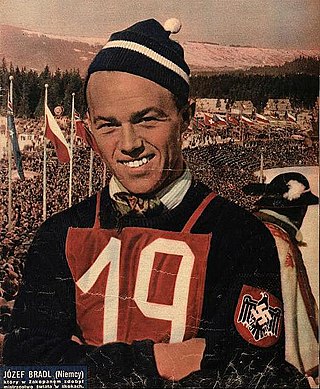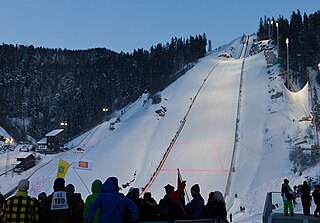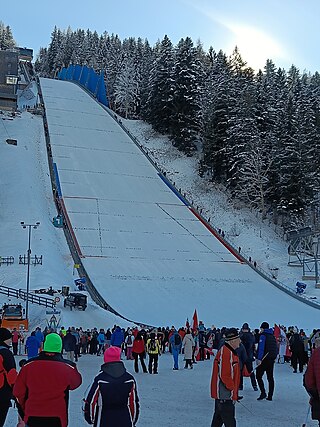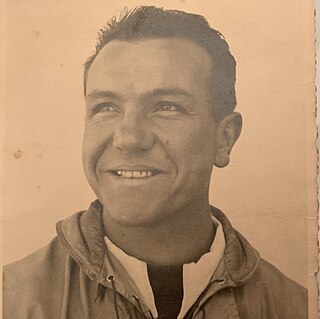
Ski jumping is a winter sport in which competitors aim to achieve the farthest jump after sliding down on their skis from a specially designed curved ramp. Along with jump length, competitor's aerial style and other factors also affect the final score. Ski jumping was first contested in Norway in the late 19th century, and later spread through Europe and North America in the early 20th century. Along with cross-country skiing, it constitutes the traditional group of Nordic skiing disciplines.

Bjørn Tore Wirkola is a Norwegian former ski jumper.

Heini-Klopfer-Skiflugschanze is a ski flying hill in Oberstdorf, Germany. It was opened in 1950, and was later renamed after its architect, Heini Klopfer. A total of 21 world records have been set on the hill. The venue should not be confused with the Schattenberg ski jumping hill, also in Oberstdorf, about 7 kilometres (4.3 mi) to the north.

Ski flying is a winter sport discipline derived from ski jumping, in which much greater distances can be achieved. It is a form of competitive individual Nordic skiing where athletes descend at high speed along a specially designed takeoff ramp using skis only; jump from the end of it with as much power as they can generate; then glide – or 'fly' – as far as possible down a steeply sloped hill; and ultimately land within a target zone in a stable manner. Points are awarded for distance and stylistic merit by five judges. Events are governed by the International Ski Federation.

Harald Smith was a Norwegian Nordic skier who won the Holmenkollen medal in 1904.

Josef "Sepp" / "Bubi" Bradl was an Austrian ski jumper who competed during the 1930s and 1950s. He was born in Wasserburg am Inn, Bavaria.
The 2006–07 FIS Ski Jumping World Cup was the 28th World Cup season. It began in Kuusamo, Finland on 24 November 2006 and finished in Planica, Slovenia on 25 March 2007. Adam Małysz, Poland won the individual World Cup. e.on Ruhrgas was this season's main sponsor, and therefore, this season's leader's jersey was red, in reference to the company, rather than the traditional yellow.

Vikersundbakken or Vikersund Hill is a ski flying hill at Vikersund in Modum, Norway. It is one of the two largest purpose-built ski flying hills in the world. Nine world records have been set there, including the current record of 253.5 meters, set by Stefan Kraft. The complex consists of a large hill, a normal hill and several training hills.
The 2007–08 FIS Ski Jumping World Cup was the 29th World Cup season in history. The season began on 1 December 2007 in Kuusamo, and finished on 16 March 2008 in Planica. The season was dominated by Austrian pair Thomas Morgenstern and Gregor Schlierenzauer who between them won 16 of the 27 individual competitions.

Kulm is a ski flying hill located in Tauplitz/Bad Mitterndorf, Styria, Austria opened in 1950.
The 2008–09 FIS Ski Jumping World Cup was the 30th World Cup season in ski jumping and the 12th official World Cup season in ski flying. It began on 29 November 2008 at the Rukatunturi ski jumping hill in Kuusamo, Finland, and finished on 22 March 2009 at Planica, Slovenia.

Trampolino Olimpico Italia is a ski jumping hill (K90), built in 1955 in Cortina d'Ampezzo, Italy. It was the site of the ski jumping, Nordic combined (K90/15.0) and team events for the 1956 Winter Olympics. The Nordic combined event used a shorter in-run to allow average jumps between 60 and 70 meters while the upper starting points on the in-run were calculated to allow jumps of 70 to 80 meters. The 1956 profile had a safety limit of 14.5 m beyond the critical point of 72 m.. Among many national and international competitions starting with the 1927 World Championships, was the inauguration of the FIS Ski Jumping World Cup in 1979. Since the venue lost its FIS-certification in 1990, the installation lies dormant. In its day, the Cortina Ski Jumping hill was regarded as one of the most innovative and still today as one of the most architecturally beautiful examples still in existence. The stadium holds a maximum of 40,000 spectators in the arena and an additional 10.000 in the stands on each side of the hill.

Howelsen Hill Ski Area is a small ski area located on Howelsen Hill in Steamboat Springs, Colorado. It is not a typical alpine ski area, as it includes a series of ski jumps, the largest with HS127.

Nels Nelsen Hill is an abandoned ski jumping hill located in Mount Revelstoke National Park near the city of Revelstoke, British Columbia, Canada. The original hill, Big Hill, was built in 1916 and was the first permanent ski jump in Canada. By 1933, three world length records had been set on the Big Hill. It fell out of use in 1939, with Revelstoke instead using the Big Bend Ski Jump.
Domenico Sandrini was an early Italian cross-country skier, Nordic combined skier, and ski jumper. He was a member of the Sci Club Ponte di Legno.

Bruno Da Col was an Italian ski jumper. He competed at the 1936 Winter Olympics and the 1948 Winter Olympics. In the town of Ponte di Legno, Da Col completed the first ski jump over 100 meters in Italy. He later received a medal of honor for his achievements from Benito Mussolini.

Olav Ulland was a Norwegian-American ski jumper who competed during the 1930s and 1940s.
Trampolino al campo Smith was a K40 ski jumping hill located in Bardonecchia, Italy.
New Bolgenschanze is an abandoned K74 ski jumping hill at Davos, Switzerland from 1928. It was located on the same road as old Bolgenschanze, approximately 500 meters away.














